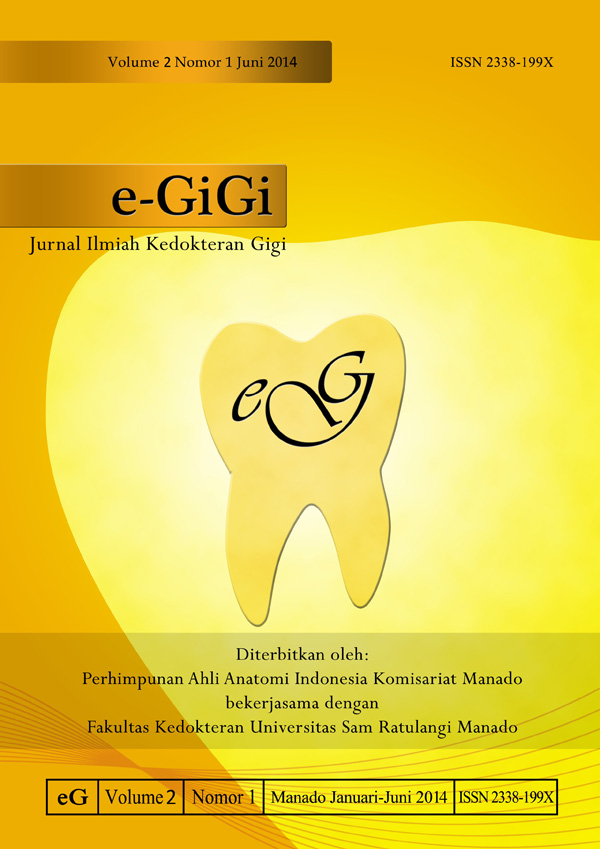GAMBARAN PENCABUTAN GIGI MOLAR SATU MANDIBULA BERDASARKAN UMUR DAN JENIS KELAMIN DI BALAI PENGOBATAN RUMAH SAKIT GIGI DAN MULUT MANADO TAHUN 2012
DOI:
https://doi.org/10.35790/eg.2.1.2014.4016Abstract
Abstract: The first molars of mandibulae are the first permanent teeth which erupt around 6-7 years old; therefore, they have the highest risk of dental caries. When the dental caries occurs in a tooth, it can lead to tooth extraction which results in new problems such as changing of teeth position, influence on occlusion, jaw joints, and mastication process. This study aimed to describe the extraction profile of the first mandibular molar based on age and gender at Balai Pengobatan Rumah Sakit Gigi dan Mulut Manado in 2012. This was a descriptive retrospective study. Samples were obtained by using total sampling method. In 2012, there were 765 patients with extracted teeth. Of the 1130 permanent teeth extracted, the highest number belonged to the first mandibular molar which was 167 teeth out of 164 patients. Extraction of the first mandibular molars among adults (19-55 years old) was 73%; teenagers (13-18 years old) 21%; children (6-12 years old) 4%; and elderies (>56 years) %. Of the 164 patients, there were 99 females and 65 males.
Conclusion: Adults were the most frequent age group with extracted first mandibular molar, followed by teenagers, children, and elderly. Female cases were more frequent than male cases.
Keywords: tooth extraction, mandibular first molar
Abstrak: Gigi molar satu mandibula merupakan gigi tetap yang pertama erupsi pada umur sekitar 6-7 tahun, sehingga menjadi gigi yang paling berisiko terkena karies. Bila gigi tersebut terkena karies, dapat berakibat pencabutan, yang menimbulkan resiko baru seperti perubahan posisi gigi, memengaruhi oklusi, sendi rahang, dan proses mastikasi yang berdampak pada penyerapan nutrisi makanan. Penelitian ini bertujuan untuk mengetahui gambaran pencabutan gigi molar satu mandibula di Balai Pengobatan Rumah Sakit Gigi dan Mulut Manado berdasarkan umur dan jenis kelamin tahun 2012. Penelitian ini bersifat deskriptif dengan jenis penelitian retrospektif. Pengambilan sampel menggunakan teknik total sampling. Hasil penelitian menunjukkan bahwa pada tahun 2012 dari 765 pasien yang melakukan pencabutan gigi, sebanyak 1130 gigi dewasa yang dicabut dan gigi molar satu mandibula yang tersering (167 gigi pada 164 pasien). Kasus pencabutan gigi molar satu mandibula pada kelompok usia dewasa dengan rentang umur 19-55 tahun sebesar 73%; pasien remaja (13-18 tahun) 21%; pasien anak-anak (6-12 tahun) 4%; dan pasien lansia dengan rentang umur mulai dari 56 tahun ke atas 2%. Dari 164 pasien yang dilakukan pencabutan gigi molar satu mandibula, jenis kelamin perempuan sebanyak 99 pasien sedangkan laki-laki 65 pasien.
Simpulan: Pasien dewasa merupakan kategori umur yang tersering dilakukan pencabutan gigi molar satu mandibula, diikuti oleh pasien remaja, anak, dan lansia. Kasus pencabutan gigi molar satu mandibula berdasarkan jenis kelamin lebih sering terjadi pada perempuan dibandingkan laki-laki.
Kata kunci: pencabutan gigi, molar satu mandibula
Downloads
Published
How to Cite
Issue
Section
License
COPYRIGHT
Authors who publish with this journal agree to the following terms:
Authors hold their copyright and grant this journal the privilege of first publication, with the work simultaneously licensed under a Creative Commons Attribution License that permits others to impart the work with an acknowledgment of the work's origin and initial publication by this journal.
Authors can enter into separate or additional contractual arrangements for the non-exclusive distribution of the journal's published version of the work (for example, post it to an institutional repository or publish it in a book), with an acknowledgment of its underlying publication in this journal.
Authors are permitted and encouraged to post their work online (for example, in institutional repositories or on their website) as it can lead to productive exchanges, as well as earlier and greater citation of the published work (See The Effect of Open Access).






